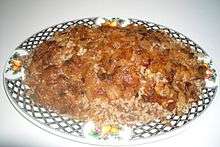Mujaddara
Mujaddara (Arabic: مجدرة mujadarah, with alternative spellings in English majadra, mejadra, moujadara, mudardara, and megadarra) consists of cooked lentils together with groats, generally rice, and garnished with sautéed onions.
 A style of Mujaddara | |
| Course | Main |
|---|---|
| Place of origin | Iraq |
| Region or state | Iraq, Lebanon, Palestine, Syria, Jordan, Turkey and Israel |
| Main ingredients | Rice or bulgur, lentils, onions |
Name and origin
Mujaddara is the Arabic word for "pockmarked"; the lentils among the rice resemble pockmarks.[1][2] The first recorded recipe for mujaddara appears in Kitab al-Tabikh, a cookbook compiled in 1226 by al-Baghdadi in Iraq.[2] Containing rice, lentils, and meat, it was served this way during celebrations.[2] Without meat, it was a medieval Arab dish commonly consumed by the poor, reputed to be a derivative of the "mess of pottage" Jacob used to buy Esau's birthright.[1] Because of its importance in the diet, a saying in the Eastern Arab world is, "A hungry man would be willing to sell his soul for a dish of mujaddara."[3]
Variations
Cooked lentils are popular all over the Middle East and form the basis of many dishes. Mujaddara is a popular dish throughout the Arab world, and is generally made using brown or green lentils and rice, that can be seasoned with cumin, coriander, or mint.[1] It is topped with fried onions and is generally served with yogurt, among other vegetables and side dishes, either hot or cold.[1]
The dish is made with brown lentils and rice. In Lebanon, the word mjaddara refers to the puréed version of the dish, rather than the version with whole grains and lentils.[4] Mjaddara usually has the consistency of rice pudding whereas in the Lebanese variant known as mudardara, the rice and lentils remain relatively intact and distinct. Both mujaddara and mudardara are topped with caramelized onions and usually served with yogurt.
Particularly in Israel and the Palestinian Territories, rice is often replaced with bulgur; the dish is called M'jaddaret-Burghul to distinguish it from the M'jaddara which is served with rice. Pronounced as m'jaddara, the dish is served multiple times a month for family, cooked with olive oil and onion strips, and served alongside local plain sheep's-milk yogurt (laban n'aj) made in Nablus, with green salad.[5][6][7][8][9]
Arab Christians traditionally eat mujaddara during Lent.[1] The dish is also popular among Jewish communities of Middle Eastern origin, in particular those of Syrian and Egyptian backgrounds; it is generally made with rice rather than wheat. It is sometimes nicknamed "Esau's favourite".[10] Jews traditionally ate it twice a week: hot on Thursday evening, and cold on Sunday.[11]
Similar dishes
In Egyptian cuisine, lentils, rice, macaroni, and tomato sauce cooked together are known as kushari. In Indian cuisines, lentils cooked together with rice are known as khichdi (see also kedgeree). In Iranian cuisine, a similar dish composed of rice and lentils is called Addas Polo.
In Cypriot cuisine, the dish called "fakes moutzentra"[12] is very similar to mujaddara, as it consists of lentils and rice. In Greek, "fakes" means lentils.
References
- Middle Eastern Kitchen, Ghillie Basan, p. 118.
- Encyclopedia of Jewish Food, Gil Marks, p. 412.
- From the lands of figs and olives: over 300 delicious and unusual recipes from the Middle East and North Africa, Habeeb Salloum and Jim Peters, p. 199.
- "Mjaddara or mdardara?". The Orange Room. Retrieved 26 August 2016.
- Hassoun, Ghazi (10 January 2013). "Walking Out into the Sunshine: Recollections and Reflections: A Palestinian Personal Experience". BookBaby. Archived from the original on 1 December 2017. Retrieved 24 April 2017.
- "UN World Food Programme". Archived from the original on 2017-12-01. Retrieved 2017-04-24.
- rice, Mujaddara (Palestinian; Says, Lentil Dish / (18 August 2014). "Mujaddara palestinian rice & lentil dish". Happiness is homemade.
- "Kitchen of Palestine Bulgur with Lentils (Mjaddara)". www.kitchenofpalestine.com.
- "Zaytoun". www.zaytoun.org.
- Roden.
- Dweck, Poopa, Aromas of Aleppo.
- Yangou, Varvara. "Φακές μουτζιέντρα". foodmuseum.cs.ucy.ac.cy (in Greek). Cyprus Food Virtual Museum. Retrieved 30 November 2015.
Notation
- Roden, Claudia, A New Book of Middle Eastern Food: London 1986 ISBN 0-14-046588-X